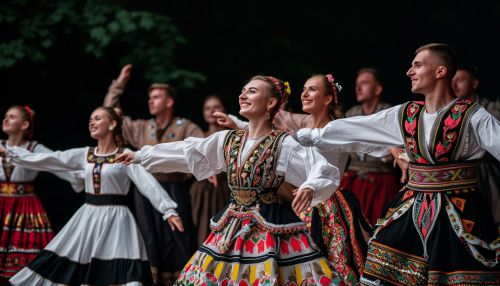Slavic folklore
Origins and Development
Slavic folklore is a branch of folklore that originates from the Slavic people, who are native to Central, Eastern, and Southeastern Europe. The Slavic people have a rich and diverse cultural heritage, which is reflected in their folklore. This folklore has evolved over centuries and is deeply rooted in the Slavic people's history, traditions, and beliefs.


The Slavic people are divided into three main groups: Eastern Slavs, Western Slavs, and Southern Slavs. Each of these groups has its own distinct folklore traditions, but there are also many common elements that unite them. The origins of Slavic folklore can be traced back to the pre-Christian era, when the Slavs were still a pagan society. Many elements of this ancient pagan belief system have been preserved in Slavic folklore, such as the veneration of nature and the belief in spirits and other supernatural beings.
Mythology and Supernatural Beings
One of the most important aspects of Slavic folklore is its mythology, which is filled with a pantheon of gods, goddesses, and other supernatural beings. These beings are often associated with natural elements and phenomena, reflecting the Slavs' deep respect for nature.
Among the most well-known of these beings are the Slavic gods, who were worshipped by the Slavs before the advent of Christianity. These gods include Perun, the god of thunder and lightning; Veles, the god of earth, waters, and the underworld; and Svarog, the god of celestial fire and blacksmithing. These gods and others were part of a complex mythological system that explained the workings of the world and the place of humans within it.
In addition to gods, Slavic folklore also features a host of other supernatural beings, such as spirits, demons, and mythical creatures. These beings often play a central role in folk tales and legends, serving as both protagonists and antagonists.
Folk Tales and Legends
Slavic folklore is rich in folk tales and legends, which are often passed down from generation to generation through oral tradition. These stories serve not only as entertainment, but also as a means of imparting moral lessons and preserving cultural values.
One of the most common types of folk tales in Slavic folklore is the fairy tale, which often features elements of magic and the supernatural. These fairy tales often involve a hero or heroine who must overcome various obstacles and challenges, often with the help of magical beings or objects.
Legends, on the other hand, are often based on historical events or figures and are used to explain the origins of certain customs, traditions, or natural phenomena. These legends often feature heroic figures who perform great deeds or make great sacrifices for the benefit of their people.
Folk Customs and Traditions
Slavic folklore also encompasses a wide range of folk customs and traditions, which are often tied to the agricultural calendar and the changing of the seasons. These customs and traditions often involve rituals, dances, songs, and other forms of expressive culture.
One of the most important of these customs is the celebration of the solstices and equinoxes, which mark the changing of the seasons. These celebrations often involve rituals designed to ensure a successful harvest, such as the burning of the Kupala bonfires on the summer solstice.
Other important customs include the celebration of weddings, births, and other life events, as well as the observance of funerary rituals and ancestor veneration. These customs often involve specific rituals, songs, and dances, which are passed down from generation to generation.
Influence on Modern Culture
Slavic folklore continues to have a significant influence on modern culture, both within the Slavic countries and beyond. This influence can be seen in a variety of areas, including literature, music, film, and visual arts.
In literature, many authors have drawn inspiration from Slavic folklore, incorporating its themes, characters, and motifs into their works. This is particularly true of fantasy literature, where Slavic folklore often serves as a rich source of material.
In music and dance, traditional Slavic folk songs and dances continue to be performed and enjoyed, both in their traditional forms and in modern adaptations. These songs and dances often feature distinctive rhythms, melodies, and dance steps that reflect the unique cultural heritage of the Slavic people.
In film and visual arts, Slavic folklore often serves as a source of inspiration for artists and filmmakers, who use its imagery, themes, and characters to create unique and compelling works of art.
